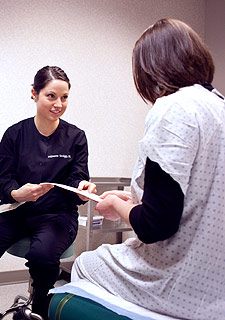Urologic Conditions
Bladder Cancer
Cancers of the kidney, bladder, prostate, and testicles are considered urologic cancers. Although not as commonly publicized as breast cancer, prostate cancer is the most commonly diagnosed cancer among men of all ethnicities and one of the leading causes of death when it goes undiagnosed. Bladder cancer is also one of the most common forms of cancer in both men and women, most commonly effecting men and women over 65. Testicular cancer, recently brought into the spotlight by pro-cyclist Lance Armstrong’s public battle with the disease, affects over 8,000 men annually but has a 95% survival rate if diagnosed early.
Though bladder cancer often affects those over 50, it can occur at any age. With regular checkups, bladder cancer is often diagnosed while it is at an early stage and still treatable. Symptoms of bladder cancer include, but are not limited to: pelvic pain, urinary frequency, and varying amounts of blood in the urine. Unlike many cancers, the rate of recurrence in bladder cancer is high. Thus, after being treated for the cancer, your doctor will likely require regular screenings of the bladder for the first four years following surgery.
Procedures
Cystoscopy
This is a simple, in-office procedure that allows your doctor to see the inside of the bladder and urethra. The physician will use a small lens equipped with fiber-optic lighting, called a cystoscope, to perform the procedure. Sometimes, the physician will also perform a biopsy, inserting a small tool through the urethra and into the bladder to collect a tissue sample for testing.
Transurethreal Resection of the Bladder Tumor
During this procedure, a cystoscopy is performed and a probe is passed through the cystoscope to remove the tumors. This probe is sometimes fit with a high-energy lazer that works to burn away cancer cells. This surgery is most often performed under general anesthesia and may result in pain or bleeding for a few days following surgery.
Radical Cystectomy
This surgery involves the removal of the entire bladder as well as the affected lymph nodes and surrounding tissue. In women, a radical cystectomy often involves the removal of the uterus, part of the vagina, as well as the ovaries. In men, radical cystectomy often involves the removal of the prostate and seminal vessels.
To allow for urination following surgery, your doctor will chose one of three methods that suits your healthcare needs and situation. The first, the ileal conduit, involves creating a small conduit that leads to a stoma in your abdomen. A tube is then attached to the stoma and drains to urine from the body to a bag that is worn at your abdomen. The second option is the creation of a small reservoir inside of your body using a section of intestine. This procedure is called cutaneous continent urinary diversion. The third option is the creation of a “neobladder,”a piece of intestine used to create a new bladder. The neobladder is connected to the urethra, and allows you to urinate in much the same way you did prior to your cystectomy.
Immunotherapy
This form of treatment for bladder cancer uses your body’s immune system to help fight the cancer. Most often, biological therapy is administered through the urethra and up into the bladder—a process known as intravesical therapy. This form of therapy works along side treatments with biological therapy drugs.
BCG
TICE® BCG is a bacterial preparation of a strain called Bacillus Calmette-Guerin, or BCG. BCG contains live bacteria that have been found to be helpful in the treatment of bladder cancers. BCG is instilled directly into the bladder so the bacteria will come in contact with the tumor cells. BCG may be an effective way to treat bladder cancers if done correctly. Your physician will ask you to schedule weekly visits for a certain period of time and provide you with specific instructions which must be followed closely in order for BCG to work.
For further information,visit the National Cancer Institute website.

Bladder Conditions
Incontinence
Interstitial Cystitis
Vaginal Prolapse
Urinary Tract Infections
Stones
Male Anatomy
Circumcision
Vasectomy
Undescended Testes
Erectile Dysfunction
Urologic Cancers
Kidney Cancer
Bladder Cancer
Prostate Cancer
Testicular Cancer